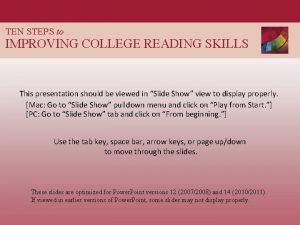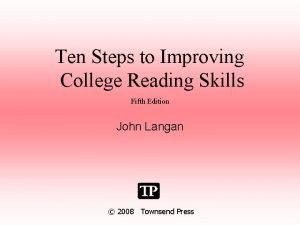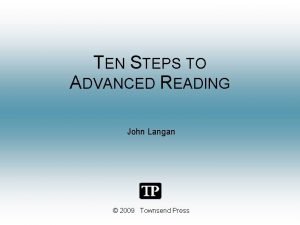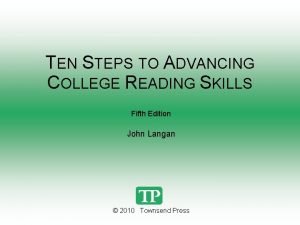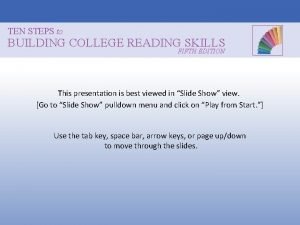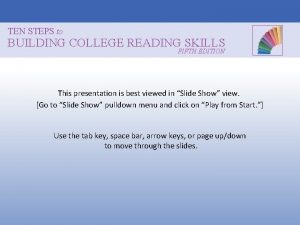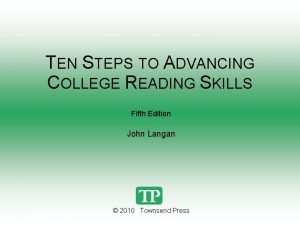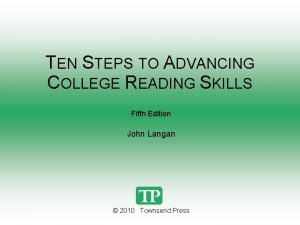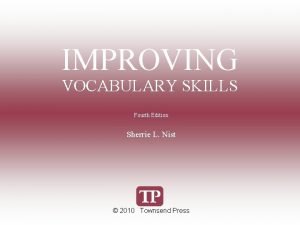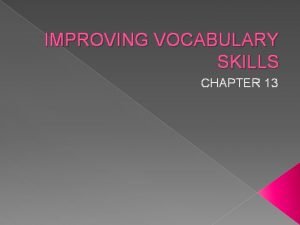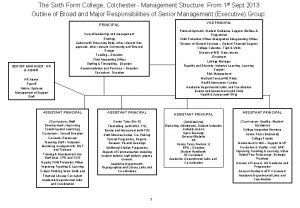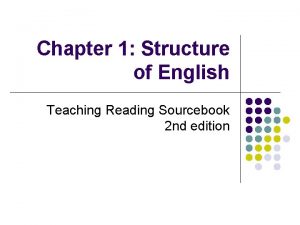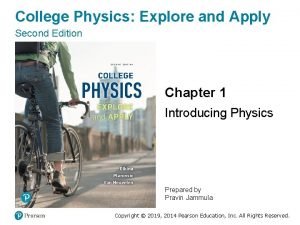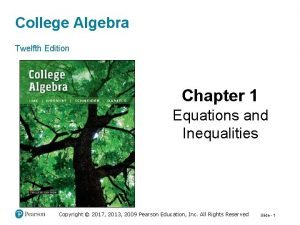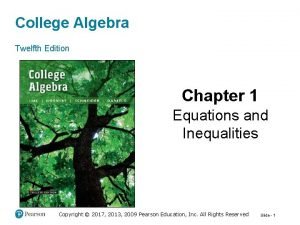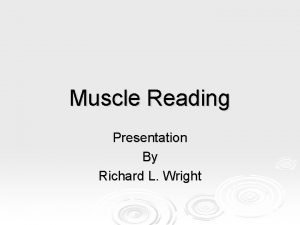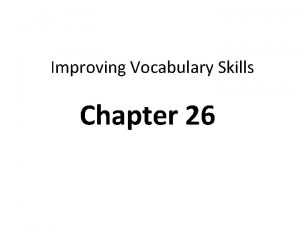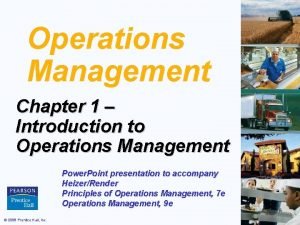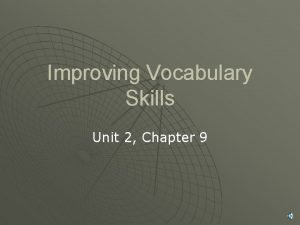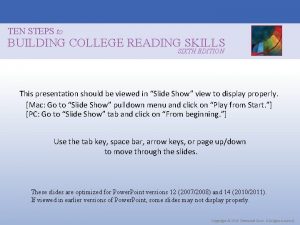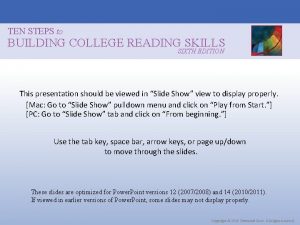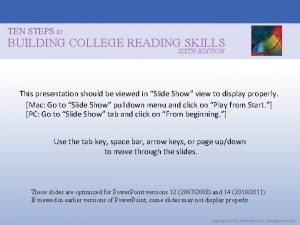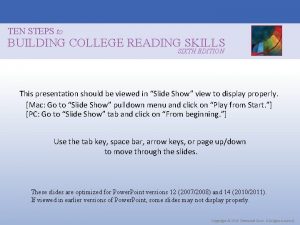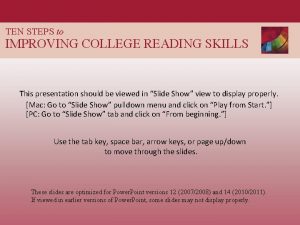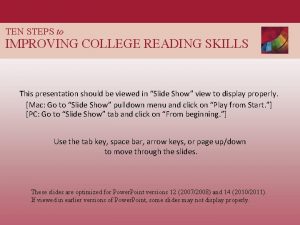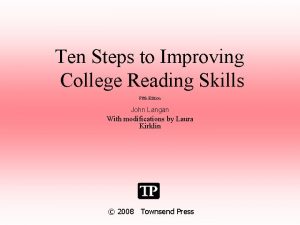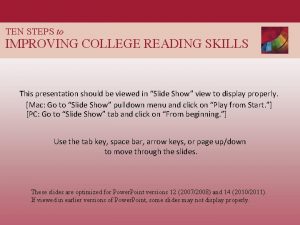SIXTH EDITION TEN STEPS to IMPROVING COLLEGE READING




























































- Slides: 60

SIXTH EDITION TEN STEPS to IMPROVING COLLEGE READING SKILLS John Langan © 2014 Townsend Press

2 Main Ideas

CHAPTER 2 Main Ideas What Is the Main Idea? “What’s the point? ” You’ve probably heard these words before. It’s a question people ask when they want to know the main same question can guide idea that someone is trying to The express. you as you read. Recognizing the main idea, or point, is the most important key to good comprehension.

CHAPTER 2 Main Ideas What Is the Main Idea? Sometimes a main idea is immediately clear, as in the cartoon below. What would you say is the speaker’s point in the cartoon? Main idea The point is that the figure of death is not a desirable date. The point is supported by the woman’s three specific reasons. 1 2 3

CHAPTER 2 Main Ideas What Is the Main Idea? To find a point in a reading selection, ask yourself: “What is the main point the author is trying to make? ”

CHAPTER 2 Main Ideas What Is the Main Idea? Read this paragraph, asking yourself, “What is the author’s point? ” School bullies have been around as long as there have been schools. Studies reveal several reasons why some children become bullies. Research shows that a certain combination of size and personality may be one factor. Bigger, more aggressive children are more likely to try to dominate their smaller, quieter peers. Another factor linked to bullying is overexposure to violent TV programs. By the time the average American child is ten years old, he or she has watched thousands of acts of violence, including assault and murder. Such exposure can lead to aggression and violence. Finally, exposure to real violence is a factor in bullying. Studies indicate that victims of bullies often turn into bullies themselves. Whether abused by family members or tormented by other kids, bullies typically learn their behavior from others. Look closely into the eyes of a bully, and you may be looking into the eyes of a former victim.

CHAPTER 2 Main Ideas What Is the Main Idea? School bullies have been around as long as there have been schools. Studies reveal several reasons why some children become bullies. Research shows that a certain combination of size and personality may be one factor. Bigger, more aggressive children are more likely to try to dominate their smaller, quieter peers. Another factor linked to bullying is overexposure to violent TV programs. By the time the average American child is ten years old, he or she has watched thousands of acts of violence, including assault and murder. Such exposure can lead to aggression and violence. Finally, exposure to real violence is a factor in bullying. Studies indicate that victims of bullies often turn into bullies themselves. Whether abused by family members or tormented by other kids, bullies typically learn their behavior from others. Look closely into the eyes of a bully, and you may be looking into the eyes of a former victim. A good way to find an author’s point, or main idea, is to look for a general statement. Then decide if that statement is supported by most of the other material in the paragraph. If it is, you have found the main idea.

CHAPTER 2 Main Ideas What Is the Main Idea? Below the paragraph are four statements from the passage. Pick out the general statement that is supported by the other material in the passage. School bullies have been around as long as there have been schools. Studies reveal several reasons why some children become bullies. Research shows that a certain combination of size and personality may be one factor. Bigger, more aggressive children are more likely to try to dominate their smaller, quieter peers. Another factor linked to bullying is overexposure to violent TV programs. By the time the average American child is ten years old, he or she has watched thousands of acts of violence, including assault and murder. Such exposure can lead to aggression and violence. Finally, exposure to real violence is a factor in bullying. Studies indicate that victims of bullies often turn into bullies themselves. Whether abused by family members or tormented by other kids, bullies typically learn their behavior from others. Look closely into the eyes of a bully, and you may be looking into the eyes of a former victim. A. School bullies have been around as long as there have been schools. B. Studies reveal several reasons why some children become bullies. C. Research shows that a certain combination of size and personality may be one factor. D. Studies indicate that victims of bullies often turn into bullies themselves.

CHAPTER 2 Main Ideas What Is the Main Idea? School bullies have been around as long as there have been schools. Studies reveal several reasons why some children become bullies. Research shows that a certain combination of size and personality may be one factor. Bigger, more aggressive children are more likely to try to dominate their smaller, quieter peers. Another factor linked to bullying is overexposure to violent TV programs. By the time the average American child is ten years old, he or she has watched thousands of acts of violence, including assault and murder. Such exposure can lead to aggression and violence. Finally, exposure to real violence is a factor in bullying. Studies indicate that victims of bullies often turn into bullies themselves. Whether abused by family members or tormented by other kids, bullies typically learn their behavior from others. Look closely into the eyes of a bully, and you may be looking into the eyes of a former victim. B. Studies reveal several reasons why some children become bullies. The phrase “several reasons” is a general one. And in fact the rest of the passage goes on to describe a series of three supporting reasons why some children become bullies. Sentence B, then, is the sentence that expresses the main idea of the passage.

CHAPTER 2 Main Ideas What Is the Main Idea? School bullies have been around as long as there have been schools. Studies reveal several reasons why some children become bullies. Research shows that a certain combination of size and personality may be one factor. Bigger, more aggressive children are more likely to try to dominate their smaller, quieter peers. Another factor linked to bullying is overexposure to violent TV programs. By the time the average American child is ten years old, he or she has watched thousands of acts of violence, including assault and murder. Such exposure can lead to aggression and violence. Finally, exposure to real violence is a factor in bullying. Studies indicate that victims of bullies often turn into bullies themselves. Whether abused by family members or tormented by other kids, bullies typically learn their behavior from others. Look closely into the eyes of a bully, and you may be looking into the eyes of a former victim. B. Studies reveal several reasons why some children become bullies. The phrase “several reasons” is a general one. And in fact the rest of the passage goes on to describe a series of three supporting reasons why some children become bullies. Sentence B, then, is the sentence that expresses the main idea of the passage.

CHAPTER 2 Main Ideas What Is the Main Idea? The Main Idea as an “Umbrella” Idea Think of the main idea as an “umbrella” idea. The main idea is the author’s general point.

CHAPTER 2 Main Ideas What Is the Main Idea? / The Main Idea as an “Umbrella” Idea Think of the main idea as an “umbrella” idea. The main idea is the author’s general point.

CHAPTER 2 Main Ideas What Is the Main Idea? / The Main Idea as an “Umbrella” Idea Think of the main idea as an “umbrella” idea. The main idea is the author’s general point. The other material of the paragraph fits under the main idea.

CHAPTER 2 Main Ideas What Is the Main Idea? / The Main Idea as an “Umbrella” Idea The other material of the paragraph fits under the main idea. That other material is made up of specific supporting details—evidence such as examples, reasons, or facts.

CHAPTER 2 Main Ideas Recognizing a Main Idea As you read through a passage, you must think as you read. If you merely take in words, you will come to the end of the passage without understanding much of what you have read. You must actively engage your mind, as you read, keep asking yourself, “What’s the point? ”

CHAPTER 2 Main Ideas Recognizing the Main Idea Here are three strategies that will help you find the main idea: 1 Look for general versus specific ideas. 2 Use the topic to lead you to the main idea. 3 Use key words to lead you to the main idea.

CHAPTER 2 Main Ideas Recognizing the Main Idea 1 Look for General versus Specific Ideas In the list of words below, which item is the general idea? A. B. C. D. dogs goldfish hamsters pets

CHAPTER 2 Main Ideas Recognizing the Main Idea / 1 Look for General versus Specific Ideas ral ne Ge Look again at the paragraph on bullies. Notice that the general idea is supported by specific ideas. a ide a ci de ifi a ec Sp ec ifi ci de Sp Sp ec ifi ci de a School bullies have been around as long as there have been schools. Studies reveal several reasons why some children become bullies. Research shows that a certain combination of size and personality may be one factor. Bigger, more aggressive children are more likely to try to dominate their smaller, quieter peers. Another factor linked to bullying is overexposure to violent TV programs. By the time the average American child is ten years old, he or she has watched thousands of acts of violence, including assault and murder. Such exposure can lead to aggression and violence. Finally, exposure to real violence is a factor in bullying. Studies indicate that victims of bullies often turn into bullies themselves. Whether abused by family members or tormented by other kids, bullies typically learn their behavior from others. Look closely into the eyes of a bully, and you may be looking into the eyes of a former victim.

CHAPTER 2 Main Ideas Recognizing the Main Idea 2 Use the Topic to Lead You to the Main Idea The topic is the general subject of a selection. Knowing the topic can help you find a writer’s main point about that topic.

CHAPTER 2 Main Ideas Recognizing the Main Idea / 2 Use the Topic to Lead You to the Main Idea Textbook authors use the title of each chapter to state the overall topic of that chapter. They also provide many topics and subtopics in boldface headings within the chapter.

CHAPTER 2 Main Ideas Recognizing the Main Idea / 2 Use the Topic to Lead You to the Main Idea But there are many times when you are not given topics—with standardized reading tests, for example, or with individual paragraphs in articles or textbooks. To find the topic of a selection when the topic is not given, ask this simple question: Who or what is the selection about?

CHAPTER 2 Main Ideas Recognizing the Main Idea / 2 Use the Topic to Lead You to the Main Idea Look again at the beginning of the paragraph you saw earlier. School bullies have been around as long as there have been schools. Studies reveal several reasons why some children become bullies. What is the paragraph about?

CHAPTER 2 Main Ideas Recognizing the Main Idea / 2 Use the Topic to Lead You to the Main Idea School bullies have been around as long as there have been schools. Studies reveal several reasons why some children become bullies. What is the paragraph about? Bullies

CHAPTER 2 Main Ideas Recognizing the Main Idea / 2 Use the Topic to Lead You to the Main Idea In fact, every sentence in the paragraph is about bullying. School bullies have been around as long as there have been schools. Studies reveal several reasons why some children become bullies. Research shows that a certain combination of size and personality may be one factor. Bigger, more aggressive children are more likely to try to dominate their smaller, quieter peers. Another factor linked to bullying is overexposure to violent TV programs. By the time the average American child is ten years old, he or she has watched thousands of acts of violence, including assault and murder. Such exposure can lead to aggression and violence. Finally, exposure to real violence is a factor in bullying. Studies indicate that victims of bullies often turn into bullies themselves. Whether abused by family members or tormented by other kids, bullies typically learn their behavior from others. Look closely into the eyes of a bully, and you may be looking into the eyes of a former victim. In addition, the word bully appears in some form eight times in the paragraph.

CHAPTER 2 Main Ideas Recognizing the Main Idea / 2 Use the Topic to Lead You to the Main Idea The next step after finding the topic is to decide what main point the author is making about the topic. School bullies have been around as long as there have been schools. Studies reveal several reasons why some children become bullies. Research shows that a certain combination of size and personality may be one factor. Bigger, more aggressive children are more likely to try to dominate their smaller, quieter peers. Another factor linked to bullying is overexposure to violent TV programs. By the time the average American child is ten years old, he or she has watched thousands of acts of violence, including assault and murder. Such exposure can lead to aggression and violence. Finally, exposure to real violence is a factor in bullying. Studies indicate that victims of bullies often turn into bullies themselves. Whether abused by family members or tormented by other kids, bullies typically learn their behavior from others. Look closely into the eyes of a bully, and you may be looking into the eyes of a former victim.

CHAPTER 2 Main Ideas Recognizing the Main Idea / 2 Use the Topic to Lead You to the Main Idea Authors often present their main idea in a single sentence. This sentence is known as the main idea sentence or the topic sentence. School bullies have been around as long as there have been schools. Studies reveal several reasons why some children become bullies. Research shows that a certain combination of size and personality may be one factor. Bigger, more aggressive children are more likely to try to dominate their smaller, quieter peers. Another factor linked to bullying is overexposure to violent TV programs. By the time the average American child is ten years old, he or she has watched thousands of acts of violence, including assault and murder. Such exposure can lead to aggression and violence. Finally, exposure to real violence is a factor in bullying. Studies indicate that victims of bullies often turn into bullies themselves. Whether abused by family members or tormented by other kids, bullies typically learn their behavior from others. Look closely into the eyes of a bully, and you may be looking into the eyes of a former victim.

CHAPTER 2 Main Ideas Recognizing the Main Idea / 2 Use the Topic to Lead You to the Main Idea Read this paragraph and decide what the topic is. Though fun to watch, chimpanzees should not be kept as pets. They are dangerously stronger than any NFL lineman. Adult chimps weigh only 100 to 160 pounds, but have been measured pulling six to nine times their own weight—with one hand. Thus, to match the strength of an average chimp, a human being would have to be able to register a two-handed pull of about a ton; it takes a very strong man to pull a quarter of that. Combined with this strength is the fact that a chimp is capable of losing its temper—for reasons known only to the chimp. Chimps signal their feelings with subtle cues of behavior that aren’t apparent to most humans. It’s quite possible for a chimp to be on the verge of violence while its owner sits unaware or even unknowingly continues to provoke it. Furthermore, it’s not wise to keep a cute young chimp and release it into the wild when it becomes dangerous. Wild-raised chimps will routinely gang up on and kill those raised in captivity. What is the topic?

CHAPTER 2 Main Ideas Recognizing the Main Idea / 2 Use the Topic to Lead You to the Main Idea Though fun to watch, chimpanzees should not be kept as pets. They are dangerously stronger than any NFL lineman. Adult chimps weigh only 100 to 160 pounds, but have been measured pulling six to nine times their own weight—with one hand. Thus, to match the strength of an average chimp, a human being would have to be able to register a two-handed pull of about a ton; it takes a very strong man to pull a quarter of that. Combined with this strength is the fact that a chimp is capable of losing its temper—for reasons known only to the chimp. Chimps signal their feelings with subtle cues of behavior that aren’t apparent to most humans. It’s quite possible for a chimp to be on the verge of violence while its owner sits unaware or even unknowingly continues to provoke it. Furthermore, it’s not wise to keep a cute young chimp and release it into the wild when it becomes dangerous. Wild-raised chimps will routinely gang up on and kill those raised in captivity. What is the topic? Chimpanzees As the first sentence of the paragraph suggests, the topic is “chimpanzees. ” Reading the paragraph, you see that, in fact, everything in it is about chimpanzees. Notice how many times chimpanzees are referred to.

CHAPTER 2 Main Ideas Recognizing the Main Idea / 2 Use the Topic to Lead You to the Main Idea Though fun to watch, chimpanzees should not be kept as pets. They are dangerously stronger than any NFL lineman. Adult chimps weigh only 100 to 160 pounds, but have been measured pulling six to nine times their own weight—with one hand. Thus, to match the strength of an average chimp, a human being would have to be able to register a two-handed pull of about a ton; it takes a very strong man to pull a quarter of that. Combined with this strength is the fact that a chimp is capable of losing its temper—for reasons known only to the chimp. Chimps signal their feelings with subtle cues of behavior that aren’t apparent to most humans. It’s quite possible for a chimp to be on the verge of violence while its owner sits unaware or even unknowingly continues to provoke it. Furthermore, it’s not wise to keep a cute young chimp and release it into the wild when it becomes dangerous. Wild-raised chimps will routinely gang up on and kill those raised in captivity. What is the main idea of this paragraph?

CHAPTER 2 Main Ideas Recognizing the Main Idea / 2 Use the Topic to Lead You to the Main Idea Ma in Id ea Though fun to watch, chimpanzees should not be kept as pets. They are dangerously stronger than any NFL lineman. Adult chimps weigh only 100 to 160 pounds, but have been measured pulling six to nine times their own weight—with one hand. Thus, to match the strength of an average chimp, a human being would have to be able to register a two-handed pull of about a ton; it takes a very strong man to pull a quarter of that. Combined with this strength is the fact that a chimp is capable of losing its temper—for reasons known only to the chimp. Chimps signal their feelings with subtle cues of behavior that aren’t apparent to most humans. It’s quite possible for a chimp to be on the verge of violence while its owner sits unaware or even unknowingly continues to provoke it. Furthermore, it’s not wise to keep a cute young chimp and release it into the wild when it becomes dangerous. Wild-raised chimps will routinely gang up on and kill those raised in captivity. What is the main idea of this paragraph? Cimpanzees should not be kept as pets. This idea is a general one that sums up what the entire paragraph is about. It is an “umbrella” statement under which all the other material in the paragraph fits.

CHAPTER 2 Main Ideas Recognizing the Main Idea / 2 Use the Topic to Lead You to the Main Idea Though fun to watch, chimpanzees should not be kept as pets. They are dangerously stronger than any NFL lineman. Adult chimps weigh only 100 to 160 pounds, but have been measured pulling six to nine times their own weight—with one hand. Thus, to match the strength of an average chimp, a human being would have to be able to register a two-handed pull of about a ton; it takes a very strong man to pull a quarter of that. Combined with this strength is the fact that a chimp is capable of losing its temper—for reasons known only to the chimp. Chimps signal their feelings with subtle cues of behavior that aren’t apparent to most humans. It’s quite possible for a chimp to be on the verge of violence while its owner sits unaware or even unknowingly continues to provoke it. Furthermore, it’s not wise to keep a cute young chimp and release it into the wild when it becomes dangerous. Wild-raised chimps will routinely gang up on and kill those raised in captivity. The parts of the paragraph could be shown as follows: Topic: Chimpanzees Main idea: Chimpanzees should not be kept as pets. Supporting details: 1. Dangerously strong 2. Capable of losing temper 3. Liable to be attacked if released in the wild

CHAPTER 2 Main Ideas Recognizing the Main Idea As you read a paragraph, remember to ask yourself these key questions: 1 2 3 Ask yourself, “What seems to be the topic of the paragraph? ” Next, ask yourself, “What point is the writer making about this topic? ” This will be the main idea. Then test what you think is the main idea by asking, “Is this statement supported by most of the other material in the paragraph? ”

CHAPTER 2 Main Ideas Recognizing the Main Idea 3 Find and Use Key Words to Lead You to the Main Idea Sometimes authors make it fairly easy to find their main idea. They announce it by using key words— verbal clues that are easy to recognize.

CHAPTER 2 Main Ideas Recognizing the Main Idea / 3 Use Key Words to Lead You to the Main Idea First to note are list words, which tell you a list of items is to follow. The main idea in the paragraph about bullies was stated like this: Studies reveal several reasons why some children become bullies. The expression several reasons helps you zero in on your target: the main idea.

CHAPTER 2 Main Ideas Recognizing the Main Idea / 3 Use Key Words to Lead You to the Main Idea Here are some common word groups that often announce a main idea: List Words Note that each of them contains a word that ends in s—a plural that suggests the supporting details will be a list of items.

CHAPTER 2 Main Ideas Recognizing the Main Idea / 3 Use Key Words to Lead You to the Main Idea List Words Many other list-word expressions are possible—“four kinds of, ” “some advantages of, ” or “three reasons for. ” So if you see a sentence with a word group like the ones above, you’ve probably found the main idea.

CHAPTER 2 Main Ideas Recognizing the Main Idea / 3 Use Key Words to Lead You to the Main Idea What are the list words in each of the sentences below? 1. Water pollution takes two forms. 2. The purchase price of a house is only one of various costs that buyers must consider. 3. Problem solving usually involves a series of four steps.

CHAPTER 2 Main Ideas Recognizing the Main Idea / 3 Use Key Words to Lead You to the Main Idea What are the list words in each of the sentences below? 1. Water pollution takes two forms. 2. The purchase price of a house is only one of various costs that buyers must consider. 3. Problem solving usually involves a series of four steps. Each of these phrases tells you that a list of details will follow.

CHAPTER 2 Main Ideas Recognizing the Main Idea / 3 Use Key Words to Lead You to the Main Idea Besides list words, addition words can alert you to the main idea. Addition words are generally used right before a supporting detail. Here are some of the addition words that often introduce supporting details and help you discover the main idea: Addition Words When you see this type of clue, you can assume that the detail it introduces fits under the umbrella of a main idea.

CHAPTER 2 Main Ideas Recognizing the Main Idea / 3 Use Key Words to Lead You to the Main Idea Reread the paragraph about bullies. As you do, pick out the addition words that alert you to supporting details. Also note the list words that suggest the main idea. School bullies have been around as long as there have been schools. Studies reveal several reasons why some children become bullies. Research shows that a certain combination of size and personality may be one factor. Bigger, more aggressive children are more likely to try to dominate their smaller, quieter peers. Another factor linked to bullying is overexposure to violent TV programs. By the time the average American child is ten years old, he or she has watched thousands of acts of violence, including assault and murder. Such exposure can lead to aggression and violence. Finally, exposure to real violence is a factor in bullying. Studies indicate that victims of bullies often turn into bullies themselves. Whether abused by family members or tormented by other kids, bullies typically learn their behavior from others. Look closely into the eyes of a bully, and you may be looking into the eyes of a former victim.

CHAPTER 2 Main Ideas Recognizing the Main Idea / 3 Use Key Words to Lead You to the Main Idea Li wo st rds School bullies have been around as long as there have been schools. Studies reveal several reasons why some children become bullies. Research shows that a certain combination of size and personality may be one factor. Bigger, more aggressive children are more likely to d quieter peers. Another factor linked to bullying is overexposure try to dominate their smaller, wor n o iti ord average American child is ten years old, he or she has wthe to violent TV programs. By the time Add n o i it Add watched thousands of acts of violence, including assault and murder. Such exposure can lead to aggression and violence. Finally, exposure to real violence is a factor in bullying. Studies ordbullies often turn into bullies themselves. Whether abused by family indicate that victims wof n o iti Add members or tormented by other kids, bullies typically learn their behavior from others. Look closely into the eyes of a bully, and you may be looking into the eyes of a former victim. Addition words introduce each new supporting detail. These addition words introduce each of the three reasons for bullying. The list words several reasons signal the supporting details will be a list of reasons for bullying.

CHAPTER 2 Main Ideas Locations of the Main Idea A main idea may appear at any point within a paragraph. Very commonly, it shows up at the beginning, as either the first or the second sentence. However, main ideas may also appear further within a paragraph or even at the very end.

CHAPTER 2 Main Ideas Locations of the Main Idea at the Beginning OR In textbooks, it is very common for the main idea to be either the first or the second sentence.

CHAPTER 2 Main Ideas Locations of the Main Idea / Main Idea at the Beginning As you read the paragraph below, look for the main idea. Spanking is a poor way to shape a child’s behavior. For one thing, spanking will result in feelings of anger and frustration. The child, then, will not learn anything positive from the punishment. In addition, spanking may actually lead to more bad behavior. Having learned that hitting is okay, the child may attack smaller children. Finally, spanking teaches children to hide certain actions from their parents. Once out of their parents’ sight, however, children may feel they can get away with the bad behavior. Which sentence contains the main idea?

CHAPTER 2 Main Ideas Locations of the Main Idea / Main Idea at the Beginning Ma in Ide a Spanking is a poor way to shape a child’s behavior. For one thing, spanking will result in feelings of anger and frustration. The child, then, will not learn anything positive from the punishment. In addition, spanking may actually lead to more bad behavior. Having learned that hitting is okay, the child may attack smaller children. Finally, spanking teaches children to hide certain actions from their parents. Once out of their parents’ sight, however, children may feel they can get away with the bad behavior. Which sentence contains the main idea? In this paragraph, the main idea is in the first sentence. All the following sentences in the paragraph provide details about the negative effects of spanking.

CHAPTER 2 Main Ideas Locations of the Main Idea / Main Idea at the Beginning Read the paragraph below and see if you can pick out the main idea. Tailgating—following too closely behind another vehicle—is a common cause of accidents. Yet tailgating accidents could be avoided if drivers followed some clear-cut guidelines. Any car that is less than two seconds behind the one ahead is definitely too close. Two car lengths is a safe following distance to maintain in local driving. Two-car accidents often become chain-reaction pileups when a number of drivers are all tailgating in a line. At freeway speeds, or in snowy, icy or foggy conditions, people should increase following distance well beyond what is normally safe. Finally, drivers who are impatient or aggressive need to develop the self-control not to express those feelings through dangerous behaviors like tailgating. Which sentence contains the main idea?

CHAPTER 2 Main Ideas Locations of the Main Idea / Main Idea at the Beginning Tailgating—following too closely behind another vehicle—is a common cause of accidents. Yet tailgating accidents could be avoided if drivers followed some clear-cut Main idea guidelines. Any car that is less than two seconds behind the one ahead is definitely too close. Two car lengths is a safe following distance to maintain in local driving. Two-car accidents often become chain-reaction pileups when a number of drivers are all tailgating in a line. At Support freeway speeds, or in snowy, icy or foggy conditions, people should increase following distance well beyond what is normally safe. Finally, drivers who are impatient or aggressive need to develop the self-control not to express those feelings through dangerous behaviors like tailgating. Intro detail Which sentence contains the main idea? The first sentence introduces the topic: tailgating. The second sentence contains the main idea. The remaining sentences support the main idea that tailgating accidents could be avoided.

CHAPTER 2 Main Ideas Locations of the Main Idea / Main Idea at the Beginning Tailgating—following too closely behind another vehicle—is a common cause of accidents. Yet tailgating accidents could be avoided if drivers followed some clear-cut guidelines. Any car that is less than two seconds behind the one ahead is definitely too close. Two car lengths is a safe following distance to maintain in local driving. Two-car accidents often become chain-reaction pileups when a number of drivers are all tailgating in a line. At freeway speeds, or in snowy, icy or foggy conditions, people should increase following distance well beyond what is normally safe. Finally, drivers who are impatient or aggressive need to develop the self-control not to express those feelings through dangerous behaviors like tailgating. Very often, a contrast word like yet, but, or however signals the main idea, as in this paragraph.

CHAPTER 2 Main Ideas Locations of the Main Idea in the Middle The main idea at times appears in the middle of a paragraph.

CHAPTER 2 Main Ideas Locations of the Main Idea / Main Idea in the MIddle Read the paragraph below and try to find the main idea. Many of us are annoyed by telemarketers who call us day and night, trying to sell us everything from magazine subscriptions to vacation homes. These electronic intruders don’t seem to care how much they are inconveniencing us and refuse to take “no” for an answer. However, nuisance callers can be stopped if we take charge of the conversation. As soon as one of them asks if we are Mr. or Ms. X, we should respond, “Yes, and are you a telephone solicitor? ” This technique puts them on the defensive. We then have an opening to say that we don’t accept solicitations over the phone, only through the mail. This puts a quick end to the conversation. Which sentence contains the main idea?

CHAPTER 2 Main Ideas Locations of the Main Idea / Main Idea in the MIddle Intro of topic Many of us are annoyed by telemarketers who call us day and night, trying to sell us everything from magazine subscriptions to vacation homes. These electronic intruders don’t seem to care how much they are inconveniencing us and refuse to take “no” for an answer. However, nuisance callers can be stopped if we take charge of the conversation. As soon as Main idea one of them asks if we are Mr. or Ms. X, we should respond, “Yes, and are you a telephone solicitor? ” This technique puts them on the defensive. We then have an opening to say that we Support don’t accept solicitations over the phone, only through the mail. This puts a quick end to the conversation. The first two sentences introduce the topic: the problem of annoying telemarketers. The third sentence then presents the main idea, which is that we can stop telemarketers from going on by taking charge of the conversation. The rest of the paragraph develops that idea by telling us how we can take charge of the conversation.

CHAPTER 2 Main Ideas Locations of the Main Idea at the End Sometimes all the sentences in a paragraph will lead up to the main idea, which is presented at the end.

CHAPTER 2 Main Ideas Locations of the Main Idea / Main Idea at the End Here is a paragraph with the main idea at the end. A study at one prison showed that owning a pet can change a hardened prison inmate into a more caring person. Another study discovered that senior citizens, both those living alone and those in nursing homes, became more interested in life when they were given pets to care for. Even emotionally disturbed children have been observed to smile and react with interest if there is a cuddly kitten or puppy to hold. Animals, then, can be a means of therapy for many kinds of individuals.

CHAPTER 2 Main Ideas Locations of the Main Idea / Main Idea at the End A study at one prison showed that owning a pet can change a hardened prison inmate into a more caring person. Another study discovered that senior citizens, both those living alone and those in nursing homes, became more interested in life when they were given pets to care for. Even emotionally disturbed children have been observed to smile and react with interest if there is a cuddly kitten or puppy to hold. Animals, then, can be a means of therapy for many kinds of individuals. Main idea

CHAPTER 2 Main Ideas Locations of the Main Idea at the Beginning and the End At times an author may choose to state the main idea near the beginning of the paragraph and then emphasize it by restating it later in the paragraph.

CHAPTER 2 Main Ideas Locations of the Main Idea / Main Idea at the Beginning and the End Here is a paragraph with the main idea at the beginning and the end. People react strongly to red. The next time you go into a bookstore, notice which books catch your eye. Those with red covers are likely to stand out. The color of blood, red puts us on the alert. Often it signals danger. Red traffic lights and stop signs tell us to halt. Red also flags problems. Errors commonly are marked in red. Debts place us “in the red. ” Red is the color of negative emotion. We redden with overexertion or embarrassment. When we’re angry, we “see red. ” But red also is associated with strong positive feelings. The red hearts and roses of Valentine’s Day speak of romance. Red cheeks convey health; red lips and nails, sexuality. Red can even confer a competitive advantage. When the colors worn by Olympic athletes in sports such as boxing were analyzed, researchers found that athletes who wore red tended to outperform opponents in blue. Apparently, red suggests power. Physiologically, our eyes are more sensitive to red than to blue or green. Asked to name any color, most adults respond, “Red. ” Red is the one color that humans simply cannot ignore.

CHAPTER 2 Main Ideas Locations of the Main Idea / Main Idea at the Beginning and the End People react strongly to red. The next time you go into a bookstore, notice which books catch your eye. Those with red covers are likely to stand out. The color of blood, red puts us on the alert. Often it signals danger. Red traffic lights and stop signs tell us to halt. Red also flags problems. Errors commonly are marked in red. Debts place us “in the red. ” Red is the color of negative emotion. We redden with overexertion or embarrassment. When we’re angry, we “see red. ” But red also is associated with strong positive feelings. The red hearts and roses of Valentine’s Day speak of romance. Red cheeks convey health; red lips and nails, sexuality. Red can even confer a competitive advantage. When the colors worn by Olympic athletes in sports such as boxing were analyzed, researchers found that athletes who wore red tended to outperform opponents in blue. Apparently, red suggests power. Physiologically, our eyes are more sensitive to red than to blue or green. Asked to name any color, most adults respond, “Red. ” Red is the one color that humans simply cannot ignore. Main idea

CHAPTER 2 Main Ideas A Note on the Central Point Just as a paragraph may have a main idea, a longer selection may have a central point, also known as a central idea or thesis. You can find a central point in the same way that you find a main idea—by identifying the topic (which is often suggested by the title of the selection) and then looking at the supporting material. The paragraphs within the longer reading will provide supporting details for the central point.

CHAPTER 2 Main Ideas A Final Thought Whether we are readers, writers, listeners, or speakers, the “heart” of clear communication is the main idea, or point, and the support for the main idea.

CHAPTER 2 Main Ideas
 Ten steps to advancing college reading skills answers
Ten steps to advancing college reading skills answers Ten steps to improving college reading skills
Ten steps to improving college reading skills Ten steps advanced reading answer key
Ten steps advanced reading answer key Ten steps to advanced reading
Ten steps to advanced reading Ten steps to advancing college reading skills
Ten steps to advancing college reading skills Ten steps to advancing college reading skills
Ten steps to advancing college reading skills Ten steps to building college reading skills
Ten steps to building college reading skills Ten steps to advancing college reading skills
Ten steps to advancing college reading skills Ten steps to advancing college reading skills
Ten steps to advancing college reading skills Mmodation
Mmodation Rubber baby buggy bumpers tongue twister lyrics
Rubber baby buggy bumpers tongue twister lyrics Chapter 2 sentence check 2 answers curt
Chapter 2 sentence check 2 answers curt Sentence check 1 chapter 13
Sentence check 1 chapter 13 Biochemistry sixth edition
Biochemistry sixth edition Computer architecture a quantitative approach sixth edition
Computer architecture a quantitative approach sixth edition Automotive technology sixth edition
Automotive technology sixth edition Automotive technology sixth edition
Automotive technology sixth edition Apa sixth edition
Apa sixth edition Computer architecture a quantitative approach sixth edition
Computer architecture a quantitative approach sixth edition Precalculus sixth edition
Precalculus sixth edition Principles of economics sixth edition
Principles of economics sixth edition Computer architecture a quantitative approach sixth edition
Computer architecture a quantitative approach sixth edition While reading activities
While reading activities Chesterton community college sixth form
Chesterton community college sixth form The sixth form college colchester
The sixth form college colchester Sixth form windsor
Sixth form windsor St michael's catholic college sixth form
St michael's catholic college sixth form Twenty past eight
Twenty past eight Ten ten siempre fuerzas y esperanza
Ten ten siempre fuerzas y esperanza Ten ten program
Ten ten program Mis chapter 6
Mis chapter 6 Mis
Mis Ten mile day reading street vocabulary
Ten mile day reading street vocabulary Teaching reading sourcebook
Teaching reading sourcebook College physics: explore and apply answers
College physics: explore and apply answers College algebra 12th edition
College algebra 12th edition College algebra 12th edition
College algebra 12th edition Locomotor dance steps
Locomotor dance steps What steps are included in phase 2 of muscle reading
What steps are included in phase 2 of muscle reading Patient registration process flowchart
Patient registration process flowchart Bronson intranet
Bronson intranet Improving vocabulary skills chapter 26
Improving vocabulary skills chapter 26 Modern software economics
Modern software economics Glencoe health chapter 12
Glencoe health chapter 12 Improving software economics set 1
Improving software economics set 1 Improving service quality and productivity
Improving service quality and productivity A linear-time heuristic for improving network partitions
A linear-time heuristic for improving network partitions Difficulties of improving quality business
Difficulties of improving quality business Improving own learning and performance examples
Improving own learning and performance examples Actual quality-communicated image gap
Actual quality-communicated image gap Starbucks inputs and outputs
Starbucks inputs and outputs A sense of belonging improving student retention
A sense of belonging improving student retention Using assessment data for improving teaching practice
Using assessment data for improving teaching practice Behavioral assessment scale for intercultural competence
Behavioral assessment scale for intercultural competence Thoughtworks code witch
Thoughtworks code witch Writing by
Writing by Improving vocabulary skills chapter 9
Improving vocabulary skills chapter 9 Improving the reliability of commodity operating systems
Improving the reliability of commodity operating systems Improving the patient journey
Improving the patient journey Improving student learning one teacher at a time
Improving student learning one teacher at a time Improving process capability means;
Improving process capability means;
